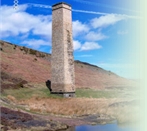The Industrial Archaeology and History of the Eastern Valley
Or click on the button to go to :-
Click on the thumbnail to enlarge a photo or map and sometimes read more about it.
Then click 'Full Size' on the toolbar to see it in all its glory.
Llantarnam, Ty Coch and Coed Eva
Caerleon Tramroad bridge - ST 3077 9368
This footpath over the Afon Llwyd had been constructed from two old wrought iron girders, believed to have been from the original Caerleon Tramroad bridge over the river, which would have been on the present-day railway alignment. The bridge has since disappeared and the footpath diverted, whether the girders were saved I don't know.

Caerleon Tramroad bridge
|

Caerleon Tramroad bridge
|
|
Burtons Biscuit Factory - ST 3060 9360
Star Brickworks - ST 3005 9415
Garfield Weston, a Canadian food manufacturer, opened the Weston Biscuit Factory in Llantarnam in 1938 eventually becoming part of the Burtons Foods group, famous for 'Wagon Wheels', 'Jammie Dodgers' and the like. The factory is still going strong in 2016.
Llantarnam Brickworks were part of Star Brick and Tile Co Ltd. The brickworks were opened C1887 and sidings to the GWR Hereford line by 1895. The claypits were to the NorthWest between the railway and Llantarnam Road with the usual narrow gauge tramways. The brickworks closed down C1964. Star Brick and Tile Co Ltd also owned the Malpas, Allt-yr-yn and Ponthir brickworks; (see under Newport). Most of the site has been re-developed as an industrial estate and housing. There were two very overgrown and dis-connected sidings at ST 3047 9378 running up to the factory perimeter from the site of the brickworks connection in 2009. Embedded rails in the footpath at ST 3023 9403 led into the 1940s Cold Storage facility and subsequent industrial estate on the site. Metalitho and Autopia car showrooms.

Star brickworks, Llantarnam, 1917
|

Cold Store and Burton's, 1949
|
|
|

Burton's sidings, Llantarnam
|

Burton's sidings, Llantarnam
|

Burton's sidings, Llantarnam
|
|

Star Brickworks sidings
|

Star Brickworks sidings
|

Star Brickworks from the air
|

A 'Star Cwmbran' brick
|
Ty Coch limekilns - ST 2873 9395
Ty Coch Top Lock and brickworks - ST 2914 9358
The restored pair of early C19th limekilns were right behind the 'white' brickworks site at ST 2873 9395. Ty Coch Top Lock was at ST 2914 9358 with a very small brickworks beside it in the 1880s, with Cabin Lock and Rachels Lock being the next two down.

Lime kilns on Ty Coch Lane
|

Ty Coch Top lock
|

Ty Coch Top lock
|

Ty Coch Top lock
|
Coed Eva Mill and The Mill Inn - ST 2841 9403
The Mill is a private house but the remains of the waterwheel still exist beside the property. It appears to date back to the early 1800s but there was probably a mill on the site way before that. The Mill Inn (latterly the Mill Tavern) next door may well date from the building of the incline, thirsty work on the tramroad but sadly, like so many pubs, it was demolished in 2012.

The Mill Inn, Coed Eva
|

Coed Eva Mill and Inn, 1880
|

Coed Eva Mill
|

Coed Eva Mill
|

Coed Eva Mill
|

Coed Eva Mill waterwheel
|

Coed Eva Mill waterwheel
|
|
The Monmouthshire Railway
Cwmbran Drive is built on the Monmouthshire Railway and Canal Co's (MRCC) main railway line from Llantarnam to Pontnewydd.
In 1981 whilst working for CDC Stan Edwards job was to secure property for Cwmbran Drive. As part of this he took photos for the records before the scheme started.
MRCC bridge under Newport Road - ST 3018 9198
The MRCC bridge under Newport Road at the end of Cwmbran Drive. The trackbed can be followed South East past Pilton Vale towards Newport for a short distance before it becomes the A4042.

MRCC bridge under Newport Road
|

MRCC bridge under Newport Road
|

MRCC bridge under Newport Road
|

MRCC bridge under Newport Road
|
Around Sneyd Lodge and Llantarnam Hall, Malpas

Llantarnam Hall, Malpas, 1936
|

Sneyd Lodge and Llantarnam Hall
|

Sneyd Lodge and Llantarnam Hall
|

Sneyd Lodge and Llantarnam Hall
|

Sneyd Lodge and Llantarnam Hall
|

Sneyd Lodge and Llantarnam Hall
|

Sneyd Lodge and Llantarnam Hall
|

Sneyd Lodge and Llantarnam Hall
|

Sneyd Lodge and Llantarnam Hall
|

Sneyd Lodge and Llantarnam Hall
|

Sneyd Lodge and Llantarnam Hall
|
|
In and around Pentre Lane bridge

Pentre Lane, 1936
|

In and around Pentre Lane bridge
|

In and around Pentre Lane bridge
|

In and around Pentre Lane bridge
|

In and around Pentre Lane bridge
|

In and around Pentre Lane bridge
|

In and around Pentre Lane bridge
|

In and around Pentre Lane bridge
|

In and around Pentre Lane bridge
|
Pentre Lane bridge
Underneath and around Pentre Lane bridge including Clawdd Du Cottage Farms crossing.

Pentre Lane, 1936
|

In and around Pentre Lane bridge
|

In and around Pentre Lane bridge
|

In and around Pentre Lane bridge
|

In and around Pentre Lane bridge
|

In and around Pentre Lane bridge
|

In and around Pentre Lane bridge
|

In and around Pentre Lane bridge
|

In and around Pentre Lane bridge
|
Pentre Lane to Ty Coch
Up the old track from Pentre Lane bridge to Clawdd Du and Cottage Farms bridge and Ty Coch Lane bridge.

Pentre Lane to Ty Coch, 1936
|

Pentre Lane to Ty Coch
|

Pentre Lane to Ty Coch
|

Pentre Lane to Ty Coch
|

Pentre Lane to Ty Coch
|

Pentre Lane to Ty Coch
|
Up to Alfa Laval
From Ty Coch to the site of the Alfa Laval factory

Llandowlais, 1936
|

Up to Alfa Laval
|

Up to Alfa Laval
|

Up to Alfa Laval
|

Up to Alfa Laval
|

Up to Alfa Laval
|

Up to Alfa Laval
|

Up to Alfa Laval
|
Llandowlais Street and Abbey Road
Around Llandowlais Street and Abbey Road

Oakfield, 1936
|

Around Llandowlais Street
|

Around Llandowlais Street
|

Around Llandowlais Street
|

Around Llandowlais Street
|

Around Llandowlais Street
|

Around Llandowlais Street
|

Around Llandowlais Street
|

Around Llandowlais Street
|
Abbey Road and Old Cwmbran
Abbey Road and Old Cwmbran

Abbey Road, Cwmbran, 1936
|

Abbey Road and Old Cwmbran
|

Abbey Road and Old Cwmbran
|

Abbey Road and Old Cwmbran
|

Abbey Road and Old Cwmbran
|

Abbey Road and Old Cwmbran
|

Abbey Road and Old Cwmbran
|
|
Cwmbran Town
The Vitriol Works - ST 294945
The Vitriol Works, generally known as the 'Chem', manufactured sulphuric acid on the Eastern side of the Monmouthshire Railway, at the end of Malpas Street. It was opened in the 1860s by james Gibbs and owned by the Cwmbran Chemical Co. It became part of ICI around 1926 but closed down c1930. The buildings were demolished in the late 1950s. In the early 1960's it was just scrub land, with odd concrete blocks and patches of blue soil and a decided 'chemically' smell. We occasionally cut through it and the brickworks site to Llandowlais Street from Victoria Street. The site has now been re-developed with retail and commercial premises.
Cwmbran Brickworks - ST 294943
Next door to the vitriol works was Cwmbran Brickworks to the North of Llandowlais Street. It isn't shown on the 1887 OS map but is on the 1902. It may well have have opened around the same time as Llantarnam brickworks. On the 1920 map its marked as 'Old Clay Pit'. The pits were used as a rubbish dump in the 1950s. The site is now occupied by Cwmbran Stadium and the road system.
Girlings and Saunders Valves - ST 298953
Girlings and Saunders Valves occupied two adjacent factories built in 1938/39 on the new Grange Road Industrial Estate, between them employing over 5000 people at their peak. They have both changed owners and names several times but are still in operation in 2008. A footpath links the recreation grounds with the Girlings car park and runs beside the rear of the factory, accessed through a small foot tunnel under the railway.

Vitriol Works, 1917
|

Cwmbran Brickworks, 1899
|

Vitriol Works in the early 1900s
|

Vitriol Works in the early 1900s
|

The Vitriol Works and brickworks
|

'Cwmbran Brick Co Newport'
|

'Cwmbran Brick Co Newport Mon'
|

'Cwmbran Brick Newport'
|

Cwmbran brickworks floor tile
|

Cwmbran brickworks floor tile
|

'Cwmbran', possibly from 'Sketch'
|

Saunders Valves on Grange Road
|

Pen-y-wain chapel and the hall
|

Pen-y-wain chapel hall
|

GWR Canal bridge sign
|
|
Canal bridge girder - ST 2924 9483
This girder was part of the original bridge over the canal and railway on Commercial Street. It was cast at Cwmbran Ironworks, owned by R J Blewitt, in 1847. The bridge was demolished in 1967 but thanks to the efforts of J W Price, the safety engineer at GKN, this girder was saved and is now displayed on the canal bank just below the bridge.

Blewitts 1847 bridge girder
|

Blewitts 1847 bridge girder
|

Blewitts 1847 bridge girder
|

Blewitts 1847 bridge girder
|
Springvale - GKN and Cwmbran Colliery
The Foundry - Guest, Keen and Nettlefolds Ltd (GKN) - ST 2891 9555
Guest, Keen and Nettlefolds were the largest employer and industrial complex in Cwmbran. My Grandfather and three uncles worked for them in the foundry. The extensive operation included the lower works, at the end of Clomendy Street (ST 290955) on the land behind the retail park. The upper works (ST 284957) were where the Springvale Industrial Estate is now and the complex ended at Cwmbran Colliery (ST 280961), where the Caerleon Tramway went on to Upper Cwmbran.
The first forge and foundry on this site began in C1800 by F.J. Blewitt, succeeded by R J Blewitt and well established with a blast furnace by the early 1840s. In 1854 the Cwmbran Iron Company were the owners, with a second blast furnace built in 1862. The forge was sold on, coming into the ownership of the Patent Nut and Bolt Co of Smethwick in 1865. They took over the blast furnaces in 1872, adding rolling mills in 1885-1895 between the blast furnaces and the colliery. So the foundry and blast furnaces formed the lower works with the rolling mills being the upper works. A larger blast furnace replaced the two originals in 1890 and the company formed the 'Keen' part of the 1902 Guest, Keen and Nettlefolds Ltd. After WW2 the works began contracting, finally closing in 1972 with the loss of 800 jobs.

GKN Blast furnaces, 1920
|

GKN Ironworks, c1970
|

GKN Ironworks, c1970
|

GKN Blast Furnace wall
|

Forgehammer lock
|

Forgehammer lock
|

GKN Ironworks canal bank
|

GKN Ironworks canal bank
|
Cwmbran Colliery - ST 2804 9614
Cwmbran Colliery began as smaller workings on coal seams close enough to the surfaceto be accessed by levels, rather than shafts. They were operating by 1854 under the Cwmbran Colliery name. The colliery was acquired in 1872 by the Patent Nut and Bolt Co, with extensive workings from the 'Main Adit' by 1895. Adjacent coke ovens, by-product plant, screens and a washery were built to feed the expanding foundry, the site providing employment for up to 1000 people. It was closed in 1927, following a counter-productive strike in the previous year. After closure, the water from the mine was pumped to Upper Cwmbran Waterworks and into the public water supply. The drainage level is known as the 'water adit' and the keystone is inscribed 'PN&BC 1879'. A mining heritage group were allowed to examine the drainage level in 2016 but found the air quality to be very poor. This tunnel constructed in 1897 was meant as a drainage adit for the main drift, it continues in for approx 700m then ends at a bricked union to the adjoining main tunnel with the spring water being led from the main drift into a 9" iron pipe which is now in pieces. Looking to the right from the end there is a 2ft hole in the red brickwork which leads into the main drift which still has its rails and 'cold spark' bell wire in places. Through the hole into the main tunnel which is a good 18" higher than the water adit, to the left there is a large collapse and no further way on can be made.. to the right the tunnel continues for some 600m until a bricked and blocked end is reached.

Cwmbran Colliery, 1920
|

'Water adit' drainage level
|

'Water adit' drainage level
|

'Water adit' drainage level
|

'Water adit' drainage level
|

'Water adit' drainage level
|

Dam above the 'water adit'
|

Inside the 'water adit'
|

'Water adit' drainage level
|
The 'Water Adit' when inspected, August 2016

'Water adit' drainage level
|

'Water adit' drainage level
|

'Water adit' drainage level
|

'Water adit' drainage level
|

'Water adit' drainage level
|

'Water adit' drainage level
|

'Water adit' drainage level
|

'Water adit' drainage level
|

'Water adit' drainage level
|

'Water adit' drainage level
|

'Water adit' drainage level
|

'Water adit' drainage level
|

'Water adit' drainage level
|

'Water adit' drainage level
|

'Water adit' drainage level
|

'Water adit' drainage level
|

'Water adit' drainage level
|

'Water adit' drainage level
|

'Water adit' drainage level
|

'Water adit' drainage level
|
The 'Main Adit'

The back wall of the Colliery
|

The back wall of the Colliery
|

The back wall of the Colliery
|

The back wall of the Colliery
|

The colliery 'main adit'
|

The colliery 'main adit'
|

The colliery 'main adit'
|

Cwmbran Colliery 'Main Adit
|

Foot of incline to Upper Cwmbran
|

Bridge at the incline foot
|

Incline to Upper Cwmbran
|

Incline to Upper Cwmbran
|

Cwmbran Colliery
|

Cwmbran Colliery
|

Cwmbran Colliery
|

Cwmbran Colliery
|
Woodside Brickworks - ST 2804 9614, ST 2880 9565 and ST 2900 9585
Woodside Brickworks was in operation by 1875 on the West bank of the canal but are shown as disused on the 1901 OS map only to have re-appeared on the East bank of the canal. The original site was cleared by 1922 and now buried under the Springvale Industrial Estate, very close to the access ramp to the nature trail. Amongst the proprietors listed in trade directories were Henry Bolt Sketch of the Woodside Brick Co (1875, 1884), I.W. Scourse and Son (1907) and the Standard Brick Co, Woodside Road (1914).

Site of Woodside Brickworks
|

Site of Woodside Brickworks
|

Site of Woodside Brickworks
|

Both Woodside Brickworks, 1901
|

'W Scourse and Son', 1907 advert
|

'Sketch' from Woodside brickworks
|

'Cwmbran' on the other side
|

'W J Scourse and Son Woodside Cwmbran Mon'
|

'Woodside Brick Co Cwmbran'
|
Pontnewydd
Railway Culvert - ST 292961
This appears to be a stormwater drain running alongside the railway (now Cwmbran Drive) opposite Pontnewydd goods yard. It was discovered during tree clearance and these photos were taken by putting a camera through a hole from loose brick.

Railway culvert on Cwmbran Drive
|

Railway culvert on Cwmbran Drive
|

Railway culvert on Cwmbran Drive
|

Railway culvert on Cwmbran Drive
|
Tynewydd tinplate works - ST 294965
Tynewydd tinplate works was founded in 1874 next to Pontnewydd railway station by Batchelor and Co (or Charles Roberts). It passed through a number of owners before becoming part of the Redbrook Tinplate Co of Monmouth. In 1904 a subsidiary, the Pontnewydd Tin Stamping Co opened a tin box factory immediately to the North of the tinplate works and sharing offices, later becoming part of Linpac. The tinplate works closed in C1961 but the stamping factory seems to have carried on until C1966. The site has been cleared and has been re-used for light industry.
Avondale tinplate works - ST 295965
The Avondale works was founded in 1876 just to the East of Tynewydd by J Williams, passing in 1885 to H T Griffiths (or H D). It became the Avondale Tinplate Co in 1894 and closed down in 1957
The Seamless Tube Works - ST 295966
The Seamless Tube Works was set up by the Ebbw Vale Steel and Iron Co in 1910 to the North of the two tinplate works but it closed down during the 1930s.
Edlogan tinplate works - ST 298973
Edlogan tinplate works dates from 1806 by John Conway, son of George Conway of the Pontnewydd works. It was also on the Eastern bank of the Afon Llwyd but right on the outskirts of the Cwmbran district at Pontrhydyrun. It relied heavily on waterpower and ceased operation in the late 1920s, the machinery being dismantled around 1946. The site and buildings are rather dilapidated but still used by a number of small businesses.

Canal milepost at the tunnel
|

Cwmbran Tunnel, Northern portal
|

Cwmbran Tunnel, Southern portal
|

Cwmbran Regatta, 2005
|

Cwmbran Regatta, 2005
|

Cwmbran Regatta, 2005
|

Cwmbran Regatta, 2005
|
|
Pontnewydd tinplate works - ST 299962 - later the Gwent Pipe and Firebrick Co
Pontnewydd tinplate works was founded in 1802 on the eastern bank of the Afon Llwyd by George Conway, next to Lower Pontnewydd station on the GWR Hereford line. It ceased production in around 1885 and is marked as 'in ruins' on the 1902, 1922 and 1954 OS maps. The site was latterly used by Gwent Pipe and Fire-brick Co making, as the name suggests, pipes and firebricks until C1974. The company became a part of Hepworth Ltd. On the Western bank of the river, the 1922 and 1954 OS maps show a Pitch and Benzole factory on the sidings of the old tinplate works.

Gwent Pipe and Firebrick Co, 1938
|

Glazed earthenware 'cap'
|

A 5 inch/125mm diameter 'cap'
|

Possibly part of a sump
|
Brickworks - ST 291970
A brickworks is shown on the 1881 OS map as 'disused'. This could have been the brickworks owned by A.H James and Co. and Davies and Co.

'Davies & Co'
|

'Pontnewydd'
|

'A H James & Co'
|

'Pontnewydd'
|
Upper Cwmbran
Garn Wen levels - ST 2668 9585
Garn Wen limekiln and quarry - ST 2704 9630
The 'trial' and 'old' levels were already old in 1882. There's very little to see of the trial level with no noticable tips. The steep, stone-built and now water-filled level seems to have been retained as a ventilation adit, probably for Mineslope. There are the foundations of some buildings close by with a substantial buttress on the laneside that could have been a tipping dock. On the hillside above is a string of equally old small quarries. The small quarry and limekiln were shown as disused by 1901. Today, the brick-arch of the kiln quietly crumbles away beside the lane. A very small airshaft and waste tip sitting in the field below Gelligravog Farm beside the public footpath at ST 2693 9656, were still shown as in use in 1920.

Garn Wen level, Upper Cwmbran
|

Garn Wen level, Upper Cwmbran
|

Garn Wen level, Upper Cwmbran
|

Garn Wen level, Upper Cwmbran
|

Garn Wen level, Upper Cwmbran
|

Garn Wen level, Upper Cwmbran
|

Garn Wen level, Upper Cwmbran
|

Garn Wen level, Upper Cwmbran
|

Garn Wen level, Upper Cwmbran
|

Garn Wen tippler and foundations
|

Garn Wen tippler and foundations
|

Garn Wen tippler and foundations
|

Garn Wen trial level and quarries
|

Garn Wen lime kiln
|

Garn Wen lime kiln
|

Garn Wen lime kiln
|
Caerleon Tramroad - from ST 2775 9641 to ST 2741 9687
There is little to see at the head of the Caerleon Tramroad incline from Cwmbran Colliery but puts the rest of the tramroad into context. The course of the Caerleon Tramroad ran along Tram Road from the incline top to the final incline at Brickyard Cottages. There are some excellently restored workers cottages on the left of Tram Road.
Woollen Mill - ST 274968
A woollen mill existed close to the bus terminus from 1822 to about 1901 (EV) but Torfaen Council mention it still at work in the 1930s in their 'figure of 8' walk leaflet. It's told that Flemish weavers influenced the design of The Square. The site might have been under the lock-up garages at the bus terminus or closer to Siloam Chapel.
Corn Mill - ST 2782 9690
The corn mill was working well before 1882 but was disused by 1901. The Mill House is now a private house.

Upper Cwmbran, 1880
|

Upper Cwmbran, 1900
|

Upper Cwmbran, 1920
|
|

Siloam Chapel, Upper Cwmbran
|

Siloam Chapel headstone
|

Upper Cwmbran waterworks
|

Wrought-iron rail
|

'T Spittle Newport' manhole cover
|

Tram Road cottages
|

Bethel Chapel, Upper Cwmbran
|

The Square, Top Row
|

Joseph Adamson crane worksplate
|

Glyn Bran Farm, Upper Cwmbran
|

Little Greenmeadow Farm
|

Well Cottages, Mountain Road
|

Well Cottages, Mountain Road
|

Glyn Bran Cottage, Upper Cwmbran
|

Glyn Bran Farm, Upper Cwmbran
|

Mountain Air quarry
|

Mountain Air quarry
|

'E' for Edlogan Manor
|

'JCH XI', Blaen Bran
|

'P I Co', above Blaen Bran
|

'L', above Blaen Bran
|

'JCH', Upper Cwmbran
|

'M de S', Upper Cwmbran
|
|
Upper Cwmbran brickworks - ST 2730 9680
The site of Parfitt's brickworks is at the top of the final incline and is now occupied by the Water Board pumping station. The brickworks opened by 1839, after high-quality clay was found at Porthmawr Colliery, as the 'Stourbridge Fire Clay Company' of Ebeneezer Rogers. the company passed to John Lawrence in 1845, who opened the Mineslope Colliery, and then Henry Parfitt in 1867. The output, when in full production was 110,000 fire bricks per week.
This brickworks made firebricks where 'Parfitt' is spelt with only one 'T', housebricks with 2 'T's were made at the Mount Pleasant Brickworks, Pontnewydd.

Upper Cwmbran brickworks
|

'Stourbridge Fire Clay Co.'
|

'Cwmbran Fireclay Co'
|

'H Parfit Cwmbran'
|

'H Parfit Cwmbran'
|

'H Parfit Cwmbran'
|

'H Parfit Cwmbran'
|
|
Mineslope Colliery - ST 2689 9692
Porthmawr Colliery - ST 2717 9699
Known variously as Cwmbran Mineslope, Porthmawr, Fireclay and Mynydd Maen, the colliery and brickworks complex were first established in 1837 by Reginald James Blewitt of Llantarnam Abbey when he opened The Porthmawr Colliery or Fireclay Level. A second level, the Mineslope Level was opened in c1854, the enterprise being taken over by the Patent Nut and Bolt Co in 1879, around the time Cwmbran Colliery was opened. There is a story of a tunnel from Porthmawr through old workings to Pontypool, used by the local residents to save the journey across the hills. It could have linked with a level at Cwmynyscoy but I wouldn't fancy pushing a Tesco trolley throught it....
The colliery closed c1916 and the engine house had been demolished by 1948 leaving just the impressive fanhouse and level entrance Unfortunately they too were reduced to rubble by an overly elf n'safety conscious council in the late 1980s, so now just the stark foundations of the engine house remain. The original Porthmawr Colliery, later the Fireclay Level, has been sinking into the ground for quite a few years. The Coal Authority have now fenced it off so it's easier to find the very boggy site.
There's so little left there now that this section relies heavily on many people who had the foresight to to take photos while it all still existed.

Collieries and brickworks, 1881
|

Collieries and brickworks, 1899
|

Collieries and brickworks, 1916
|
|

Mineslope Colliery Quarry
|

Porthmawr Colliery, 1837 level
|

Incline from Tram Road to Colliery
|

Mineslope Colliery foundations
|

Mineslope Colliery lamp house
|

Mineslope iron mine
|

Coal seam near Colliery
|

Coal seam near Colliery
|
Historical photos of Mineslope and Porthmawr Collieries
Many thanks to all the photographers that recorded the area before it was bulldozed

Mineslope Colliery, 1981
|

Mineslope Colliery, 1981
|

Mineslope Colliery, 1982
|

Mineslope Colliery, 1982
|

Mineslope Colliery fan house
|

Mineslope Colliery fan house
|

The Engine House wall
|
|

Mineslope Colliery
|

Mineslope Colliery, 1970
|

Mineslope Colliery fanhouse, 1977
|

Mineslope Colliery fanhouse, 1977
|

Mineslope Colliery, 1982
|

Mineslope Colliery, 1982
|

Mineslope Colliery, 1987
|

Mineslope Colliery, 1987
|

Mineslope Colliery, 1989
|

Mineslope Colliery fanhouse, 1989
|

Mineslope Colliery engine house
|

Porthmawr Colliery level, 1982
|
Blaen Bran reservoirs - ST 2670 9710
The lower Blaenbran reservoir in the beautiful Blaenbran Community Woodland was built in 1884 and enlarged in 1930 with the addition of a filtration plant. It is now derelict and a very corroded access gantry has recently been removed. In 2012 the reservoir still had a good pool of water supporting a sizeable shoal of fish. The upper reservoir was built around 1914 and, having been levelled, is now just a depression in the ground but the concrete spillways and odd bits of ironmongery are worth seeking out. Chris Harris of the Bush Inn, Upper Cwmbran says that the odd mechanism maybe less than 30 years old. The owners of the reservoir at that time rented the area to paintball operators and they erected a metal frame to make a simple shelter for lunches etc. This was covered with a tarpaulin which was wound back around a mandrel in a trench in the ground by a crank connected by a bike chain. An ingenious use for old surroundings.

Blaen Bran reservoirs
|

Blaen Bran reservoir
|

Blaen Bran reservoir
|

Paintball channel and control
|

Paintball channel and control
|
|
Acknowledgments, sources and further reading.
Thanks for the use of their photographs to :-
Stan Edwards, Chris Jackson, Lawrence Skuse and Dennis Hopkins from his website :-
D C Hopkins, the sadly defunct cwmbran.info website and some good people I don't know (please get in touch if it's you).
There's a lot more photos of the Cwmbran Colliery drainage level here :-
28 days later
A Guide to the Website
Industrial Wales
Collieries, Ironworks, Quarries, Railways, Canals, Tramroads, Tunnels, Culverts and so much more....
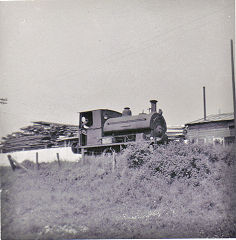
|
Brickworks of Wales
Bricks are 'History with a label' so here's the story of the Brickworks of Wales - photos, maps and the products themselves
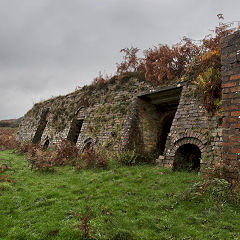
|
Around the World
My travels around the UK and the Whole Wide World in search of industries, railways, trams and mines to name a few.
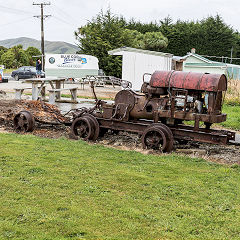
|
Boundary Stones and Mileposts
Boundary Stones, Mileposts and other markers in simple alphabetical order of their initials, name or site.
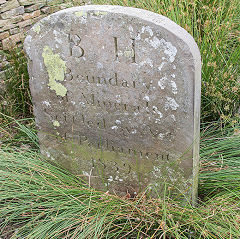
|
Ships and Shipping
Ships around the World in simple alphabetical order of their name (or apparent area if I can't read the name).

|
The Site Map and Index
A full list of all the pages of the whole website in just one place, so you should find exactly what you are looking for.
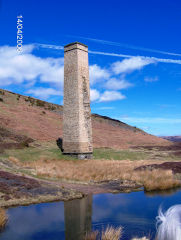
|
About the Site
The background and technical details about the site, plus a contact page and links to other sites - and a warning !!
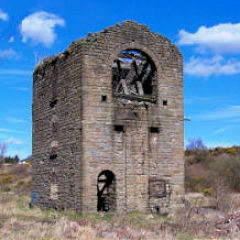
|
Contact Me
Something to add? A great photo? Something wrong? or need to know more about things? Just drop me a line here.

|
Further Reading
You can find lots of local and other very helpful websites, books, magazines and Facebook groups all listed here.
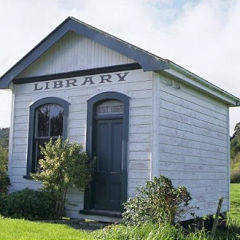
|
All rights reserved - Phil Jenkins
